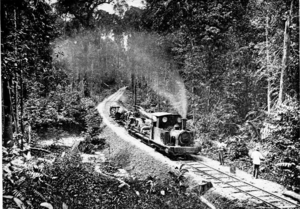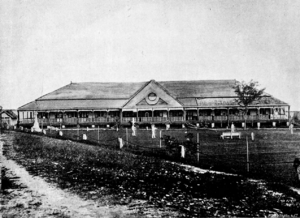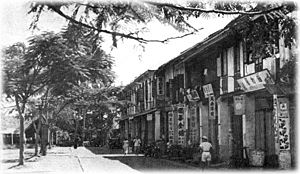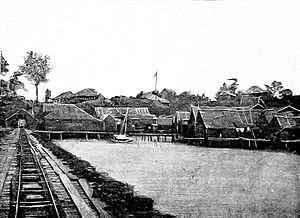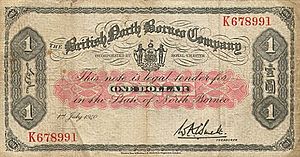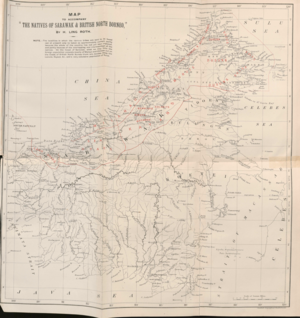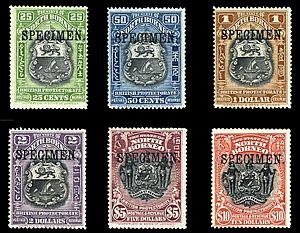North Borneo facts for kids
Quick facts for kids
North Borneo
Borneo Utara
|
|||||||||||||||||||
|---|---|---|---|---|---|---|---|---|---|---|---|---|---|---|---|---|---|---|---|
| 1881–1942 1945–1946 |
|||||||||||||||||||
|
Motto: Latin: Pergo et Perago
(I persevere and I achieve) |
|||||||||||||||||||
|
Anthem:
God Save the King/Queen |
|||||||||||||||||||
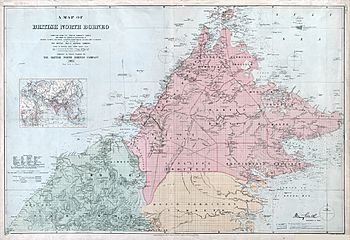
Map of North Borneo, 1903
|
|||||||||||||||||||
| Status | Protectorate of the United Kingdom | ||||||||||||||||||
| Capital | Kudat (1881–1884); Sandakan (1884–1945); Jesselton (1946) |
||||||||||||||||||
| Common languages | English, Kadazan-Dusun, Bajau, Murut,Lundayeh, Sabah Malay, Chinese etc. | ||||||||||||||||||
| Government | Chartered company, Protectorate | ||||||||||||||||||
| Governor | |||||||||||||||||||
|
• 1881–1887
|
William Hood Treacher (first) | ||||||||||||||||||
|
• 1937–1946
|
Charles Robert Smith (last) | ||||||||||||||||||
| Historical era | New Imperialism | ||||||||||||||||||
|
• North Borneo Provisional Association Ltd
|
26 August 1881 | ||||||||||||||||||
|
• Granted royal charter
|
1 November 1881 | ||||||||||||||||||
|
• North Borneo Chartered Company
|
May 1882 | ||||||||||||||||||
|
• Protectorate
|
12 May 1888 | ||||||||||||||||||
|
• Japanese invasion
|
2 January 1942 | ||||||||||||||||||
| 10 June 1945 | |||||||||||||||||||
|
• Ceded to the Crown colony
|
15 July 1946 | ||||||||||||||||||
| Currency | North Borneo dollar | ||||||||||||||||||
|
|||||||||||||||||||
| Today part of | Malaysia | ||||||||||||||||||
North Borneo, also known as British North Borneo, was a special area in the northern part of the island of Borneo. Today, this area is part of Sabah, a state in Malaysia. It was a "protectorate" of the United Kingdom. This means Britain protected it, but a private company managed its daily affairs.
The story of North Borneo began in 1877–1878. A businessman named Gustav Overbeck got rights to the land from the rulers of Brunei and Sulu. Overbeck had bought some land earlier from an American merchant, Joseph William Torrey.
Later, Overbeck passed his rights to Alfred Dent in 1879. In 1881, Dent created the North Borneo Provisional Association Ltd. This company was given a special permission from the Queen, called a royal charter. The next year, this company became the North Borneo Chartered Company. Other countries like Spain and the Netherlands were worried about Britain's growing power. To avoid problems, a deal called the Madrid Protocol was signed in 1885. This deal set clear borders for Spanish influence. To protect North Borneo even more, it officially became a British protectorate in 1888.
North Borneo was important for its timber (wood) and agriculture (farming). These were the main ways the British made money there. Since there weren't enough local workers, the British brought in many Chinese and Japanese immigrants to work on farms and in other businesses. However, World War II changed everything. Japanese forces took over, and North Borneo became a crown colony after the war.
Contents
A Look into North Borneo's Past
How North Borneo Started
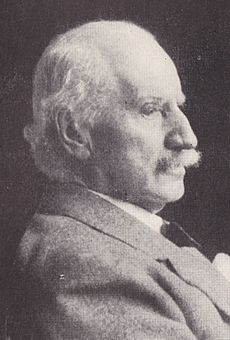
North Borneo began in 1877–1878. This happened when Gustav Overbeck, a businessman, leased large areas of land. He got these lands from the rulers of Brunei and Sulu. Overbeck had already bought some land on the western coast. A friend, William Clark Cowie, helped him get more land on the eastern coast.
Overbeck tried to get support from countries in Europe, but only Great Britain showed interest. Britain wanted to control trade routes in the Far East. They already had a presence nearby in Crown Colony of Labuan since 1846. So, British brothers Alfred Dent and Edward Dent gave Overbeck money. The British government also gave him diplomatic and military help. Because of this, a rule was added: the land could not be sold to another country without Britain's permission.
In 1879, Overbeck left, and all his land rights went to Alfred Dent. In 1881, Dent formed the North Borneo Provisional Association Ltd. This company got a royal charter from Queen Victoria on November 1, 1881. William Hood Treacher became the first governor. Kudat was chosen as the first capital city. This royal charter made the Dutch and Spanish worried about Britain's power in the region.
In May 1882, the Provisional Association was replaced by the North Borneo Chartered Company. This company was a private business, but it followed government rules. Its goal was to protect the area from other European powers. Under Governor Treacher, the company gained more land from the Sultanate of Brunei. They expanded their control to several rivers and islands, including the Mantanani Islands.
Spain also claimed parts of northern Borneo. To avoid conflicts, Britain, Germany, and Spain signed the Madrid Protocol in 1885. This agreement recognized Spain's control over the Philippine islands. To prevent more international issues, North Borneo became a British Protectorate on May 12, 1888. Later, the Crown Colony of Labuan joined North Borneo's administration for a while. There were some local uprisings, like the Mat Salleh revolt from 1894 to 1900. The First World War did not greatly affect the area. Logging became a big business during this time.
World War II and the End of the Protectorate

During World War II, Japanese forces invaded Borneo. They landed in Miri and Seria on December 16, 1941, to get oil supplies. On January 1, 1942, the Japanese navy landed in Labuan. The next day, they landed in North Borneo. Jesselton was occupied by the Japanese on January 8. By the end of January, the Japanese had taken over all of North Borneo. The protectorate had relied on the British navy for defense and did not have its own army.
Many British and Australian soldiers captured in other parts of Asia were brought to North Borneo. They were held as prisoners of war (POWs) in places like Sandakan camp. Some were forced to go on the terrible Sandakan Death March. The war made life very hard for people in North Borneo. Many moved inland to find food and escape the harsh conditions. Some local groups formed resistance movements, like the Kinabalu Guerrillas led by Albert Kwok.
The Allied forces launched a campaign to take back their territories. Australian troops played a big part in liberating Borneo. They landed on Tarakan and Labuan islands. Allied special units gathered important information about the Japanese. Most major towns in North Borneo were heavily bombed during this time. The war ended on August 15, 1945, when Japan surrendered. The British Military Administration (BMA) took over. The North Borneo Chartered Company tried to manage the territory again. However, they could not afford to rebuild after the war. So, on July 15, 1946, they handed over control to the crown colony government.
How North Borneo Was Governed
The North Borneo Chartered Company used a system similar to other British colonies. The land was divided into large areas called Residencies. These were then split into smaller Districts. At first, there were two Residencies: East Coast and West Coast. Their main offices were in Sandakan and Jesselton. Each Residency had Districts run by officers. By 1922, there were five Residencies. These were West Coast, Kudat, Tawau, Interior, and East Coast. They were divided into 17 districts. British officials held the top jobs. Local chiefs managed people at the village level. This was a practical way to govern, as British officers were new to local customs.
The company helped bring peace to the land. Before, there were problems with piracy and local conflicts. The company stopped slavery. They also set up transportation, health, and education services. They allowed local communities to keep their traditional ways of life. The police force, called the British North Borneo Constabulary, had officers from different backgrounds. These included Europeans, Indians, Dayaks, Somalis, and Malays.
Even though North Borneo was a protectorate, the British government handled its international relations. But inside, the North Borneo Chartered Company governed it like an independent state. A treaty signed on May 12, 1888, explained this relationship. It said that Britain would protect North Borneo. But Britain would not interfere with its internal management, unless the treaty allowed it. The treaty also stated that North Borneo could not sell any land to another country without Britain's permission.
North Borneo's Economy
The British administration started planned economic activities. They opened up land for agriculture (farming). They also set up rules for native land rights. The government felt there weren't enough local workers for modern development. So, they encouraged Chinese workers from Hong Kong and China to move there. In 1882, Walter Henry Medhurst was appointed to attract more Chinese workers. This effort was expensive and didn't fully succeed. However, many Hakka people came anyway and became successful farmers.
Since the 1700s, tobacco was a very important crop in North Borneo. Logging (cutting timber) also started in the 1870s. By the 1890s, wood exports grew, especially between the two World Wars. In the 1900s, North Borneo joined the rubber boom. The North Borneo Railway Line was built to transport goods to ports on the west coast. By 1915, a lot of land was planted with rubber trees. In the same year, Governor Aylmer Cavendish Pearson invited Japanese immigrants to help with the economy. The Japanese government was happy to help and sent researchers to find business opportunities.
At first, the Japanese encouraged their farmers to grow rice in North Borneo. Japan needed to import rice. As Japanese interest grew, they bought a rubber farm from the North Borneo government. By 1937, North Borneo exported more timber than even Siam (now Thailand). Many private Japanese businesses were involved in North Borneo's economy. With more Japanese investments, many Japanese families moved to the east coast, especially to Tawau and Kunak.
Money Used in North Borneo
The first money used in North Borneo was the Mexican dollar. It was worth 100 cents. Later, the North Borneo dollar was linked to the Straits dollar. Different banknotes were printed during the administration. They often showed Mount Kinabalu or the company's symbols.
People and Life in North Borneo
Who Lived There?
In 1881, about 60,000 to 100,000 local people lived in North Borneo. Those living near the coast were mostly Muslims. People living inland were mainly aborigines. The Kadazan-Dusun and Murut were the largest local groups in the interior. Along the coast, groups like the Bajau, Bruneian, Illanun, Kedayan, and Suluk were common.
After the British brought in immigrants, the population grew a lot. It reached 200,000 in 1920, and 331,000 by 1945. The government brought in not only Chinese workers but also Japanese immigrants. This was to make sure there were enough people to work in the growing economy. The number of Chinese people increased from 27,801 in 1911 to 74,374 in 1951. They belonged to different groups like Hakka, Cantonese, Hokkien, and others.
Public Services and Connections
North Borneo was connected to the world by a special underwater cable. This cable linked the island of Labuan to Menumbok on the mainland. From there, it connected to Singapore and Hong Kong. The first message from Borneo to London was sent on May 19, 1894. Soon after, work began on a telegraph line from the West Coast to Sandakan. This was a difficult project, taking three years. But on April 7, 1897, a message from the Governor in Sandakan was successfully sent to London.
In the early 1900s, there were problems with the telegraph line. So, the company started building a wireless network. This network had stations in Sandakan, Jesselton, Tawau, and Kudat. The first wireless message was sent on October 24, 1913, between North Borneo and Jolo in the Philippines. Communication within North Borneo started on January 14, 1914, between Sandakan and Jesselton.
The North Borneo Railway opened to the public on August 1, 1914. It became the main way to travel and transport goods on the west coast. Postal service was also available throughout the British administration.
News and Records
Important records about North Borneo were kept in publications like the Journal of the Royal Asiatic Society (since 1820) and the British North Borneo Herald (since 1883). These sources give us a lot of information about the area before and during British rule.
See also
- History of Sabah
- Postage stamps and postal history of North Borneo
- Postal orders of British North Borneo




